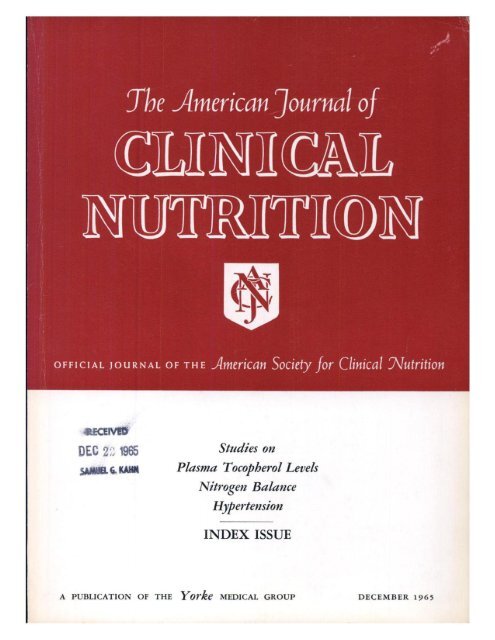相对于通常的孕期保健,接受饮食和运动干预的孕妇的后代在情绪调节的多个方面发生了适应性变化:随机对照试验。
IF 6.5
1区 医学
Q1 NUTRITION & DIETETICS
引用次数: 0
摘要
背景:有关产前饮食和/或运动干预对后代神经发育影响的人类研究结果不一。包括提供全营养食品、营养咨询、解决运动行为问题以及利用多种方法评估后代情绪调节的干预措施可能会更好地揭示这些干预措施对神经发育的影响:目的:探讨 "孕期健康"(BHIP)产前饮食与运动干预是否能改善22个月大后代的情绪调节能力:在妊娠12-17周期间招募孕妇(18岁以上,单胎妊娠),并将其随机分配到干预组(通过提供松软干酪、希腊酸奶、低脂牛奶、个性化双周营养咨询、有控制的步行计划和孕期常规护理(UPC)来控制高蛋白能量饮食)或对照组(仅UPC)。利用孕妇及其伴侣对儿童行为检查表和执行功能行为评级量表-学前版的报告,以及检查抑制控制、注意力和移情能力的实验室观察任务和高频心率变异性(HF-HRV),对后代(年龄=22.2(SD=4.04);50.9%为女性;干预组:n=29;对照组:n=28)的ER进行评估:结果:接受 BHIP 干预的儿童在孕妇和伴侣报告的外化方面表现出中等到较大的效应大小的减少(效应大小ƞ2pmother=0.08,95% CI 的差异[0.05,7.14];ƞ2ppartner=0.17[1.68,9.65])、内化ƞ2pmother=0.08[0.09,5.32]; ƞ2ppartner=0.13[0.84,8.88])和总的行为问题ƞ2pmother=0.09[0.72,11.87]; ƞ2ppartner=0.17[3.17,17.88])。孕妇(而非伴侣)在抑制控制(ƞ2p=0.13[1.40,8.55])、认知灵活性(ƞ2p=0.08[0.18,4.85])、突发元认知(ƞ2p=0.14[2.00,11.59])和整体执行功能(ƞ2p=0.14[3.37,20.12])方面的问题较少。干预儿童的冲动行为较少(ƞ2p=0.11[0.16,1.77]),注意力集中时间较长(ƞ2p=0.08[0.30,13.34])。最后,干预儿童表现出更高的基线高频-高反应性(ƞ2p=0.10[0.16,2.01]),以及在冲动(ƞ2p=0.12[0.20,2.19])和注意力(ƞ2p=0.21[0.74,2.77])任务中的适应性高频-高反应性反应:该干预措施对后代ER的改善具有中/大效应。需要更大规模的试验来证实这些干预措施对后代神经发育的潜在影响:临床试验登记:NCT01689961,2012 年 9 月 21 日。本文章由计算机程序翻译,如有差异,请以英文原文为准。
Adaptive changes in multiple aspects of emotion regulation in the offspring of pregnant persons receiving a diet-and-exercise intervention relative to usual pregnancy care: a randomized controlled trial
Background
Human studies examining the influence of prenatal diet and/or exercise interventions on offspring neurodevelopment are mixed. Interventions that include the provision of whole foods, nutritional counseling, address exercise behaviors, and that utilize multimethod assessments of offspring emotion regulation (ER) may better reveal the impact of these interventions on neurodevelopment.
Objectives
To explore whether the Be Healthy in Pregnancy (BHIP) prenatal diet-and-exercise intervention improves ER in 22-mo-old offspring.
Methods
Pregnant persons (>18 y, singleton pregnancy) were recruited between 12 and 17 wk gestation and randomly assigned to the intervention [high protein energy-controlled diet via the provision of cottage cheese, Greek yogurt, low-fat milk, individualized biweekly nutritional counseling, a controlled walking program, and usual pregnancy care (UPC)] or control (UPC alone) groups. ER in offspring [mage = 22.2 (SD = 4.04); 50.9% female; intervention: n = 29, control: n = 28] was assessed using reports from pregnant persons and their partners on the Child Behavior Checklist, and the Behavior Rating Inventory of Executive Function-Preschool Version, laboratory observational tasks examining inhibitory control, attention, and empathy, and high-frequency heart rate variability (HF-HRV).
Results
Children exposed to the BHIP intervention exhibited medium to large effect size reductions in pregnant person and partner reported externalizing [effect size ƞ2pmother = 0.08, 95% confidence interval of the difference (0.05, 7.14); ƞ2ppartner = 0.17 (1.68, 9.65)], internalizing [ƞ2pmother = 0.08 (0.09, 5.32); ƞ2ppartner = 0.13 (0.84, 8.88)], and total behavior problems [ƞ2pmother = 0.09 (0.72, 11.87); ƞ2ppartner = 0.17 (3.17, 17.88)] relative to control participants’ children. Pregnant persons, but not partners, reported fewer problems with inhibitory control [ƞ2p = 0.13 (1.40, 8.55)], cognitive flexibility [ƞ2p = 0.08 (0.18, 4.85)], emergent metacognition [ƞ2p = 0.14 (2.00, 11.59)], and global executive function [ƞ2p = 0.14 (3.37, 20.12)]. Intervention children displayed fewer impulsive behaviors [ƞ2p = 0.11 (0.16, 1.77)] and a longer attention span [ƞ2p = 0.08 (0.30, 13.34)]. Finally, intervention children exhibited greater baseline HF-HRV [ƞ2p = 0.10 (0.16, 2.01)], and adaptive HF-HRV reactivity during the impulsivity [ƞ2p = 0.12 (0.20, 2.19)], and attention tasks [ƞ2p = 0.21 (0.74, 2.77)].
Conclusions
This intervention was associated with medium/large effect size improvements in offspring ER. Larger trials are needed to confirm the potential of these interventions on offspring neurodevelopment.
Trial registration number
This trial was registered at www.clinicaltrials.gov as NCT01689961 (21 September, 2012).
求助全文
通过发布文献求助,成功后即可免费获取论文全文。
去求助
来源期刊
CiteScore
12.40
自引率
4.20%
发文量
332
审稿时长
38 days
期刊介绍:
American Journal of Clinical Nutrition is recognized as the most highly rated peer-reviewed, primary research journal in nutrition and dietetics.It focuses on publishing the latest research on various topics in nutrition, including but not limited to obesity, vitamins and minerals, nutrition and disease, and energy metabolism.
Purpose:
The purpose of AJCN is to:
Publish original research studies relevant to human and clinical nutrition.
Consider well-controlled clinical studies describing scientific mechanisms, efficacy, and safety of dietary interventions in the context of disease prevention or health benefits.
Encourage public health and epidemiologic studies relevant to human nutrition.
Promote innovative investigations of nutritional questions employing epigenetic, genomic, proteomic, and metabolomic approaches.
Include solicited editorials, book reviews, solicited or unsolicited review articles, invited controversy position papers, and letters to the Editor related to prior AJCN articles.
Peer Review Process:
All submitted material with scientific content undergoes peer review by the Editors or their designees before acceptance for publication.

 求助内容:
求助内容: 应助结果提醒方式:
应助结果提醒方式:


